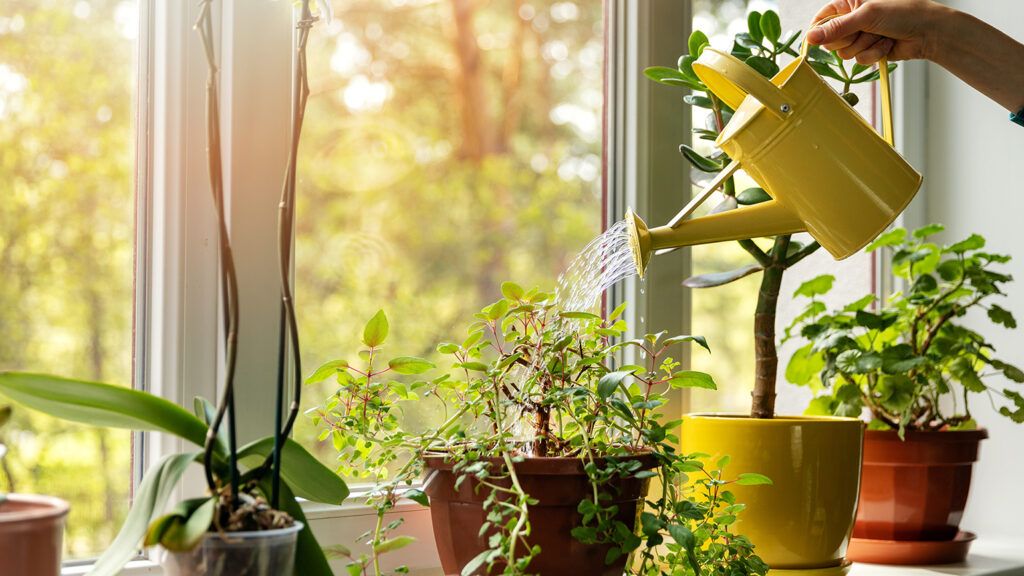If you’re like me, you’ve never been able to keep a plant for more than a few weeks. Maybe a month. I just never grew up with plants in the house (I definitely inherited my mom’s black thumb). Every house plant I bought or got as a gift didn’t last long. My old roommate joked that I could kill a cactus.
When the Covid-19 pandemic hit and we all went into quarantine, I saw many of my friends show off their house plants on social media. Their living rooms and bedrooms popped with beautiful plant life, while they noted the many physical and psychological benefits of having indoor plants. Why can’t that be me? I thought. So when my friend offered me a spider plant sprout, I decided to try something I’d never done before: commit to becoming a plant person.
The journey hasn’t been without its ups and downs. I made a lot of mistakes. But after doing research and changing my perspective, I can proudly say I am succeeding. Here are five ways to take on house plants when, like me, you do not have a green thumb.
- Start with Easy Plants
Like taking on any major project, it’s best to start simply. I can’t tell you how many plants I killed because I didn’t realize they were difficult plants. Just water and sunlight, right? Apparently not. Orchids, ferns, and fig trees are beautiful, but they require a lot of care and know-how. So as a beginner, I decided to take a different approach when cultivating my indoor garden. I focused my efforts on easy plants, such as Chinese evergreens, peace lilies, spider plants, English ivy, and various succulents. These plants grow easily, have basic needs, and aren’t as temperamental as some other plants.
- Research!
It might seem like a pain but doing a little research can be the difference between your plant surviving and thriving. Look up how much sunlight the plant needs, how often to water it, what temperature it does best in, and if it requires any special care. It usually isn’t that complicated, especially if you start with simpler plants. Write down some of the basics and keep them on notecards near the plants. And don’t be afraid to ask for help. There are tons of resources and forums out there filled with plant lovers that know how to deal with the ups and downs of plant care.
- Create a Watering Schedule
Watering has always been a weak point in my plant care. I killed a lot of indoor plants because I over watered them. Too much water can drown the plant, prevent it from getting the nutrients it needs from the soil and can lead to root rot. On the other hand, I’ve also killed plants because I didn’t water them enough. Usually it slipped my mind and I simply forgot to water them! Not watering your plant enough can cause it to dry out and die very quickly. After doing a little research, I made a watering schedule to make sure I didn’t over or under water my plants. It got me to make plant care a part of my daily schedule, instead of just an afterthought.
- Cater to the Plant
When I first got my spider plant, I put it in a colorful pot and set it on my windowsill. It looked beautiful and matched perfectly with my living room. However, after just a few weeks, I noticed the plant leaves were losing their green color. I was giving it plenty of sunlight and water, so I couldn’t understand what I was doing wrong! After a little research, I learned spider plants don’t do well with intense afternoon sunlight, which was exactly the kind of sunlight it was getting. So I completely rearranged all my plants in my living room to cater to their specific sunlight needs. Because I prioritized the plants’ needs over what I thought looked best, my plants are now thriving more than ever.
- Do It with Love
Perhaps the most profound change I made with caring for my plants was changing my mindset. Before, I always considered the watering, repotting, and trimming to be a chore. Something on my to-do list like doing the dishes or folding laundry. Getting my spider plant sprout forced me to reconsider my perspective. I started viewing the time I spent caring for plants as time I was also caring for myself. It got me to get up, take a break from my computer screen—and focus on another living thing. I even started listening to music and singing while I do it. (Did you know that some studies indicate that singing to your plants can be good for them? It releases carbon dioxide which the plant needs and then, in turn, uses it to produce fresh oxygen for you!) I now look forward to my time with my plants, and that has made all the difference in their health— and mine.




